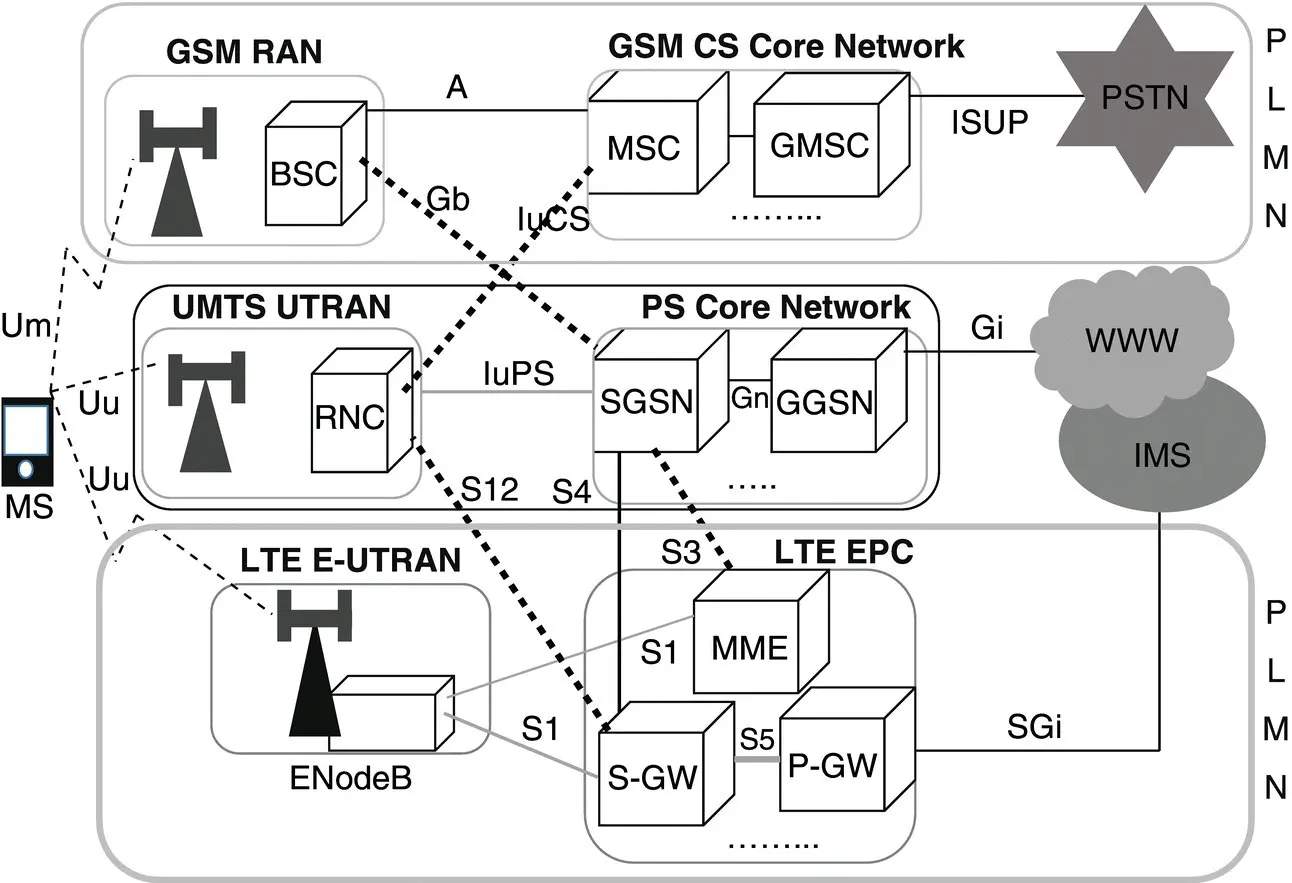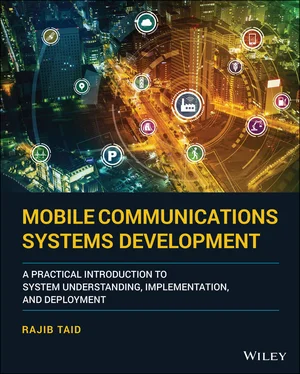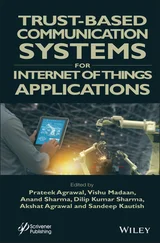In addition to the existing connections with the legacy GSM and UMTS network elements, the LTE/EPC SGSN also interconnects with the Mobility Management Entity (MME), Serving Gateway (S‐GW) of an EPC network. Similarly, the S‐GW is a centralized core network element for the interworking of user data/traffic between the LTE/EPC and the UMTS PS domain core networks.
Figure 1(b) TS 23.002 [29] contains a basic interworking configuration where the voice call services may be provided through the GSM network (left side); voice and data services through the UMTS network (middle part); only data services through the LTE/EPS network (right side) during its initial rollout. This high‐level interworking configuration may appear to be complex in the first place because of the numerous network elements that are interconnected through various logical interfaces as indicated by the bold and thin solid lines. Look at this figure from the UE/MS, in the bottom‐up approach, toward the core network. Identify the access network and code network followed by the CS domain and PS domain network. From Figure 1(b) TS 23.002 [29], it is observed that the interworking among the GSM, GPRS, UMTS, and LTE/EPS networks is available at the core network level only, and no interworking is available at the radio access network level.
To offer voice as well as data services through an LTE/EPS network only, the operator requires to deploy additional IP transport‐based network components along with the EPC network shown in Figure 1(b) TS 23.002 [29]. On the other hand, an operator may choose to provide LTE/EPS data services only while it may continue to provide a voice call through the legacy GSM, UMTS network. Such provision requires interworking capabilities among the networks and their components deployed by an operator.
In the next sections, we will discuss the following interworking features that facilitate an LTE/Evolved‐UMTS Terrestrial Radio Access Network (E‐UTRAN) network registered UE and its user to make a voice call over an LTE/EPS network, in coexistence with the legacy GPRS Edge Radio Access Network (GERAN) and UMTS terrestrial radio access network (UTRAN).
Voice‐over IP Multimedia Subsystem (IMS) or voice‐over LTE (VoLTE),
Single Radio Voice Call Continuity (SRVCC), and
Circuit‐Switched Fallback (CSFB).
For these features to work, both the CS domain and PS domain core network elements, Mobile Switching Centre (MSC) and SGSN, are upgraded from its legacy networks, i.e. GSM/GPRS, UMTS. The network elements are upgraded in terms of new functions and procedures that are to be performed by the respective network element. The new functions and procedures are specified in the form of a new logical interface between two network elements. The dark dashed lines in the following illustrative figures show the existing, as well as the new logical interfaces for realizing a particular interworking feature through signaling or user traffic, flows between two network elements.
6.2.1 Interworking for Voice Call Through IMS: VoLTE
To provide both the voice and data services to subscribers over an LTE/EPS, an IMS may be deployed and interworked through the SGi interface further with the LTE EPC network. The provision for providing voice services to subscribers over the LTE system and IMS is called the VoLTE. One such network deployment scenario providing VoLTE services is illustrated in Figure 6.1.
Along with the LTE/EPS network and its IMS configuration, the handset must be also VoLTE capable to enable a user to make a voice call over an LTE network. A VoLTE‐capable UE can work on different networks, i.e. GSM, UMTS, and LTE using different Radio Access Technologies (RATs).

Figure 6.1 Illustration: LTE network and IMS interworking for VoLTE call.
As shown in the above interworking scenario, a voice call can be facilitated to a user through the legacy GSM, UMTS network, or LTE/EPS IMS. A UE indicates its preference for a voice call through the Voice domain preference and UE’s usage setting IE in the ATTACH Request message, TS 24.301 [46], TS 24.008 [45], that is sent to the core network during its initial registration of a UE. The same IE is also sent to the core network as part of the Routing Area Update (RAU) (GPRS, UMTS) and Tracking Area Update (TAU) (LTE/EPS) request to indicate its voice domain preference by a UE. An LTE UE that does not support the voice‐over IMS feature will indicate the preference as the “ CS voice only” . In such a case, the UE will use the CS fallback method of providing a voice call facility to a user.
An LTE UE that support the voice‐over IMS feature will indicate the preference as the “IMS PS voice only”. All these interworking possibilities of providing voice and data services depend on the capabilities of a UE and its usage setting, which is described in the next section. Below we briefly describe the IMS and its network elements that are interworked with an LTE/EPC to provide a VoLTE call facility to subscribers.
6.2.1.1 IP Multimedia Subsystem (IMS)
The IMS is the core network infrastructure backbone for offering common IP‐based multimedia, e.g. audio, video, voice, and services to subscribers over an LTE/EPS IP transport network. The IMS contains the core network elements and interfaces, interconnecting them for routing of a VoLTE call either to a 2G/3G network or PSTN network or within an IMS network accordingly. The reference architecture, the network elements, and various interfaces of an IMS system are shown in Figure 6.2. For more information on this reference architecture, refer to TS 23.228 [36]. The IMS was standardized for mobile communications networks and was introduced as part of the 3rd Generation Partnership Project (3GPP) Release 5 architecture to provide voice calls along with other multimedia services.
The main network elements of an IMS is the call session control function ( CSCF) and the media gateway control function ( MGCF ) . As shown in Figure 6.2, the CSCF performs several roles: Proxy CSCF, Interrogating CSCF, and Serving CSCF.
Proxy‐CSCF (P‐CSCF)

Figure 6.2 Reference architecture of an IMS.
Source: © 2015. 3GPP ™ TSs and TRs are the property of ARIB, ATIS, CCSA, ETSI, TSDSI, TTA and TTC who jointly own the copyright in them. © 2015, 3GPP.
The information sent by a UE is received first at the P‐CSCF and is forwarded to the I‐CSCF.
Interrogating CSCF (I‐CSCF)
I‐CSCF contacts the Home Subscriber Server (HSS), and based on the response from the HSS, it forwards the call to the S‐CSCF.
Serving CSCF (S‐CSCF)
The S‐CSCF handles the registration of UEs, maintains sessions, and performs routing functions.
MGCF
The MGCF interconnects the IMS with PSTN or CS domain network element. For a mobile‐terminated (MT) call, the MGCF contacts the I‐CSCF. For more information on the above CSCFs, refer to TS 23.228 [36].
The signaling protocol that is used to exchange information between a UE and the IMS is known as the Session Initiation Protocol ( SIP ) which uses the IP transport network. IMS uses the SIP messages to perform various functions and procedures such as registration, call establishments and release, session management, authentication, security, and charging. Though the SIP messages exchanged between a UE and the IMS are signaling/control plane information in nature with respect to the IMS, they are treated as user plane data by the E‐UTRAN and its core network. The real‐time voice packets are transferred through other protocols called Real‐Time Transport Protocol ( RTP ) and RTP Control Protocol ( RTCP ) . For more information on the IMS, the reader is recommended to refer to TS 23.228 [36].
Читать дальше














